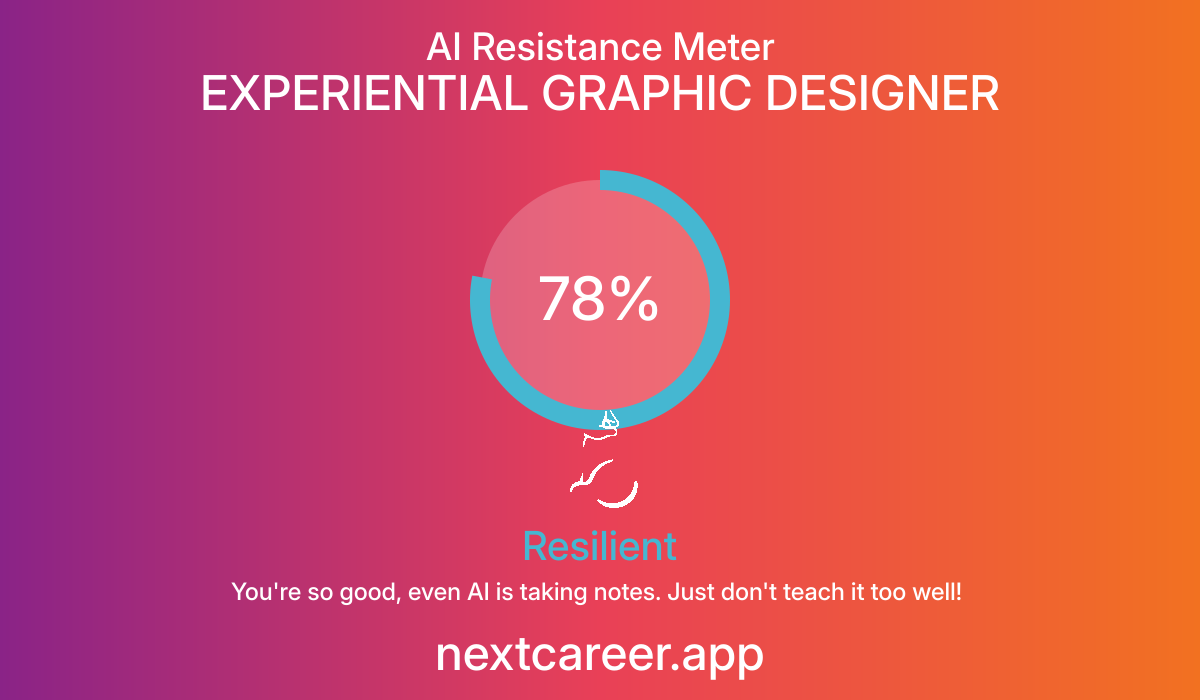AI Resistance Analysis
EXPERIENTIAL GRAPHIC DESIGNER
EXPERIENTIAL GRAPHIC DESIGNER
AI Resistance Score
AI Resistance Meter
Resilient
EXPERIENTIAL GRAPHIC DESIGNER
You're so good, even AI is taking notes. Just don't teach it too well!
Experiential Graphic Designers create visual solutions that enhance environments, focusing on user experience, storytelling, and spatial design. While AI can assist with generating design elements or optimizing layouts, the role requires a high degree of emotional intelligence and creative thinking to craft compelling narratives and designs that resonate with users. This creative aspect alongside collaboration with stakeholders poses a barrier to full automation. However, the increasing capabilities of AI in automating routine tasks and certain creative processes can influence the role's evolution and workflow.
Experiential Graphic Designers create visual solutions that enhance environments, focusing on user experience, storytelling, and spatial design. While AI can assist with generating design elements or optimizing layouts, the role requires a high degree of emotional intelligence and creative thinking to craft compelling narratives and designs that resonate with users. This creative aspect alongside collaboration with stakeholders poses a barrier to full automation. However, the increasing capabilities of AI in automating routine tasks and certain creative processes can influence the role's evolution and workflow.
Key Factors
- Cognitive Tasks: While AI can streamline research and provide data-driven insights for design optimization, the unique cognitive task of integrating aesthetics with user experience presents challenges for AI.
- Emotional Intelligence: The ability to empathize with users and translate their feelings into design experiences is a core requirement of this role, which AI currently lacks.
- Physical Skills: The role involves some physical skills in terms of presenting designs and installation, but these aspects are less likely to be affected by AI advancements.
- Creative Thinking: AI's capability in generating creative content is improving, yet the nuanced understanding of cultural contexts and advanced creative synthesis needed remains largely a human domain.
Human Advantages
- The capacity for empathy and understanding complex human emotions is imperative for crafting user-centric designs.
- A deep understanding of cultural contexts and storytelling enhances the ability to create meaningful experiences that resonate with specific audiences.
- The ability to collaborate and communicate effectively with clients and stakeholders allows for tailored design solutions that meet unique requirements.
AI Vulnerabilities
- AI can assist in generating design concepts and automating repetitive design tasks, reducing the time and effort for standard projects.
- Tools that incorporate AI can analyze user interaction data to provide insights that designers may not otherwise access.
Recommended Actions
- Emphasize the development of interpersonal skills and emotional intelligence through workshops and training.
- Engage in lifelong learning to stay updated with AI tools and technologies that can augment design processes.
- Cultivate a strong understanding of cultural and societal trends to enhance narrative-building in design.
- Collaborate with technologists to explore how to integrate AI into the design process without losing the human touch.
In the near-term (5 years), AI tools will continue to enhance the workflow for Experiential Graphic Designers, increasing efficiency and allowing for more data-driven designs. However, the need for human touch in emotional connectivity and creative expression will persist. In the long-term (20+ years), as AI becomes more integrated into design processes, the role may shift towards more strategic oversight, monitoring AI-generated outputs, and focusing on complex problem-solving and conceptualization that technology cannot fully replicate.

Why Calculate AI Resistance?
Understanding how AI-resistant your career is becoming increasingly important in today's rapidly evolving job market. Our analysis combines multiple factors including required human skills, technological adaptability, and future industry projections to give you a comprehensive view of your career's sustainability.